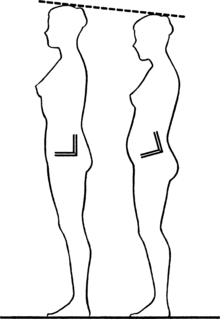Lower back pain?
Might be due, at least in part, to the tilt of your pelvis.
Due to a variety of factors: lots of sitting, bad postural habits, and effects of gravity – the pelvis can become misaligned into an excessive anterior tilt. Specifically, this means the top of the pelvis is tilted forward beyond its usual natural position. See Pelvic Tilt Talk Part 1 and Part 2.
A little tilt forward is natural
 Yes, a slight anterior tilt of the pelvis is natural to good posture of we upright humans, in what is known as neutral pelvis. But it is very common for that tilt to go overboard creating an excessive anterior tilt, resulting in problems in the low back and abdominal wall. These problems can work their effects all the way up the top of the back as well.
Yes, a slight anterior tilt of the pelvis is natural to good posture of we upright humans, in what is known as neutral pelvis. But it is very common for that tilt to go overboard creating an excessive anterior tilt, resulting in problems in the low back and abdominal wall. These problems can work their effects all the way up the top of the back as well.
As the pelvic tilt is brought back into normal position, and out of excessive tilt, there is often a corresponding relief from back pain. This is because it takes a load off the muscles that are being – well, overloaded, and can also relieve compression on the discs of the spine.
There are specific muscles that have a tendency to shorten and tighten, thus contributing to the anterior tilt of the pelvis. At the same time, the muscles that contribute to tilting the pelvis in a posterior direction can become lengthened and weakened.
The trick is to bring the muscle activation around pelvic carriage back into balance for more functional movement, relief from pain, and the resulting drain of your energy that excessive tilt can bring.
Stretch, strengthen, or both?
A combination of stretching strategies AND strengthening exercises work together to bring balance and correct carriage to the pelvis. Together, they correct the excessive anterior tilt of the pelvis.
Simultaneously, building strength in other specific, oppositional muscles assists in creating a better pelvic tilt profile.
In Parts 4, Stretches to correct excessive anterior pelvic tilt and Part 5, Strengthening exercises to offset excessive anterior pelvic tilt of this series, we’ll look at specific strengthening and stretching exercises that you can to do tame an over active anterior pelvic tilt.
If you haven’t already done so, remember to download your Interval Training Guide and Free Fit Quickie video by clicking here now >>>




Excellent topics, I like this. I know HealthSource Chiropractic and Progessive Rehab Rye Brook, NY their commitment to their patients has led to develop a center consisting of state of the art treatment using the revolutionary FDA cleared DRX spinal decompression equipment.
Where is part 4 and part 5?
Here you go:
Part 4: http://www.lanimuelrath.com/back-pain/stretches-to-correct-excessive-anterior-pelvic-tilt-pelvic-tilt-talk-part-4-of-5/
Part 5: http://www.lanimuelrath.com/back-pain/strengthening-exercise-to-offset-excessive-anterior-pelvic-tilt/
I do not even know the way I stopped up right here, however I assumed this publish used to be good.
I do not know who you are but definitely you’re going to a well-known blogger should you aren’t already.
Cheers!